Antibody data
- Antibody Data
- Antigen structure
- References [1]
- Comments [0]
- Validations
- Immunocytochemistry [1]
- Immunohistochemistry [3]
- Other assay [1]
Submit
Validation data
Reference
Comment
Report error
- Product number
- PA5-57636 - Provider product page

- Provider
- Invitrogen Antibodies
- Product name
- DNAH6 Polyclonal Antibody
- Antibody type
- Polyclonal
- Antigen
- Recombinant protein fragment
- Description
- Immunogen sequence: TKLNTILCQT FVFCYLWSLG GNLTENYYDS FDTFIRTQFD DNPDARLPNS GDLWSIHMDF DTKRLDPWER IIPTFKYNRD VP Highest antigen sequence identity to the following orthologs: Mouse - 93%, Rat - 89%.
- Reactivity
- Human
- Host
- Rabbit
- Isotype
- IgG
- Vial size
- 100 μL
- Concentration
- 0.2 mg/mL
- Storage
- Store at 4°C short term. For long term storage, store at -20°C, avoiding freeze/thaw cycles.
Submitted references G-quadruplexes originating from evolutionary conserved L1 elements interfere with neuronal gene expression in Alzheimer's disease.
Hanna R, Flamier A, Barabino A, Bernier G
Nature communications 2021 Mar 23;12(1):1828
Nature communications 2021 Mar 23;12(1):1828
No comments: Submit comment
Supportive validation
- Submitted by
- Invitrogen Antibodies (provider)
- Main image
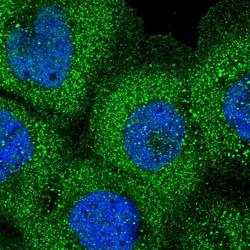
- Experimental details
- Immunofluorescent staining of DNAH6 in human cell line A-431 shows positivity in plasma membrane, cytoplasm & nucleus but excluded from the nucleoli. Samples were probed using a DNAH6 Polyclonal Antibody (Product # PA5-57636).
Supportive validation
- Submitted by
- Invitrogen Antibodies (provider)
- Main image
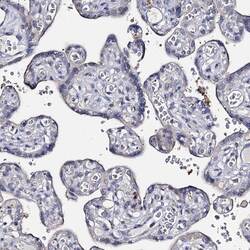
- Experimental details
- Immunohistochemical staining of DNAH6 in human placenta using DNAH6 Polyclonal Antibody (Product # PA5-57636) shows low expression as expected.
- Submitted by
- Invitrogen Antibodies (provider)
- Main image
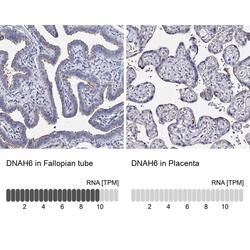
- Experimental details
- Immunohistochemical staining of DNAH6 in human fallopian tube and placenta tissues using DNAH6 Polyclonal Antibody (Product # PA5-57636). Corresponding DNAH6 RNA-seq data are presented for the same tissues.
- Submitted by
- Invitrogen Antibodies (provider)
- Main image
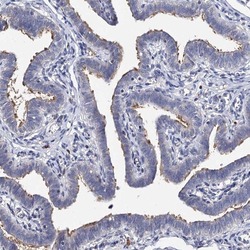
- Experimental details
- Immunohistochemical staining of DNAH6 in human fallopian tube using DNAH6 Polyclonal Antibody (Product # PA5-57636) shows high expression.
Supportive validation
- Submitted by
- Invitrogen Antibodies (provider)
- Main image
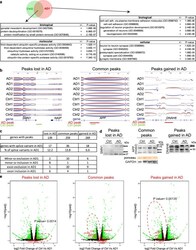
- Experimental details
- Fig. 5 1H6 peaks are enriched at key regulatory elements of neuronal genes. a Venn diagram and Gene Ontology analysis of genes associated with peaks common to both Ctrl2 and AD1 neurons or specific to AD neurons (AD1). The most significant pathways are indicated on the diagram along with the respective P value calculated by the GO algorithm. b Sashimi plot of three different loci containing a 1H6 peak and associated with a differential splicing event. Exons are represented as blue boxes. The red lines represent a peak found in AD neurons; the green lines represent a peak found in control (Ctrl) neurons green. Loss of the intragenic peak in AD neurons between the SMN1 and NAIP genes is associated with the formation of cryptic fusion transcripts. The common peak found at the APP locus (but increased in AD) is associated with loss of some minor isoforms in AD neurons. The unique peak gained in AD neurons at the DNAH6 locus is associated with loss of minor isoforms and a large splicing gap in AD neurons. c Table showing the number of genes containing a 1H6 peak, as well as the number of genes that entailed a differential splicing event associated with a 1H6 peak when comparing Ctrl1 and Ctrl2 neurons with AD1 neurons. The splicing events were subdivided into loss of a minor isoform or formation of a gap junction. d Western blot analyses of Ctrl2 and AD2 neurons. GAPDH and ponceau were used as normalizers. Black arrows indicate differentially expressed protein variants. e Volcano
 Explore
Explore Validate
Validate Learn
Learn Immunocytochemistry
Immunocytochemistry